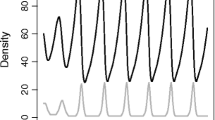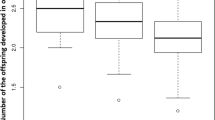Summary
Three models of the evolution of host-feeding behaviour in parasitoid wasps are developed. The first assumes that the wasp host feeds purely to obtain resources to mature eggs (limited resource model) while the second assumes that host feeding provides energy for maintenance (pro-ovigenic model). The third model assumes that host feeding provides resources for both maintenance and egg maturation (resource pool model). Two variants of the third model are examined: the first assumes that the risk of mortality is constant and state-independent, the second that resource-depleted individuals suffer a higher risk of mortality. The models are analysed using a combination of stochastic dynamic programming and analytical techniques. The models make different predictions about the relationships between the probability of host feeding and egg load and host density. The available experimental evidence best supports the resource pool model.
Similar content being viewed by others
References
van Alphen, J.J.M. and Vet, L.E.M. (1986) An evolutionary approach to host finding selection. InInsect Parasitoids (J.K. Waage and D. Greathead, eds.), pp. 23–61 Academic Press, London.
van Alphen, J.J.M. and Visser, M.E. (1990) Superparasitism as an adaptive strategy for insect parasitoids.Ann. Rev. Entomol. 35, 59–79.
Chan, M.S. (1991) Host feeding in parasitic wasps: a study of population patterns generated by individual behaviour. Unpublished PhD thesis, University of London.
Charnov, E.L. (1982)The Theory of Sex Allocation. Princeton University Press, Princeton, USA.
Charnov, E.L. and Skinner, S.W. (1984) Evolution of host selection and clutch size in parasitoid wasps.Fla. Entomol. 67, 5–21.
Charnov, E.L. and Skinner, S.W. (1985) Complementary approaches to the understanding of parasitoid oviposition decisions.Environ. Entomol. 14, 383–91.
Charnov, E.L. and Skinner, S.W. (1988) Clutch size in parasitoids: the egg production rate as a constraint.Evol. Ecol. 2, 167–74.
Charnov, E.L. and Stephens, D.W. (1988) On the evolution of host selection in solitary parasitoids.Am. Nat. 132, 707–22.
Collins, M.D., Ward, S.A. and Dixon, A.F.G. (1981) Handling time and functional response ofAphelinus thomsoni, a predator and parasite of the aphidDrepanosiphon platanoides.J. Anim. Ecol. 50, 479–87.
DeBach, P. (1943) The importance of host feeding by adult parasites in the reduction of host populations.J. Econ. Entomol,36, 647–58.
Godfray, H.C.J. (1987a) The evolution of clutch size in invertebrates.Oxf. Surv. Evol. Biol. 4 117–54.
Godfray, H.C.J. (1987b) The evolution of clutch size in parasitic wasps.Am. Nat. 129, 221–33.
Godfray, H.C.J. (1993)Parasitoids: Behavioural and Evolutionary Ecology. Princeton University Press, Princeton USA (in press).
Godfray, H.C.J., Partridge, L. and Harvey, P.H. (1991) Clutch size.Ann. Rev. Ecol. Syst. 22, 409–29.
Houston, A.I., Clark, C., McNamara, J. and Mangel, M. (1988) Dynamics models in behavioural and evolutionary ecology.Nature 332, 29–34.
Houston, A.I., McNamara, J.M. and Godfray, H.C.J. (1991) The effect of variability on host feeding and reproductive success in parasitoids.Bull. Math. Biol. 54, 465–76.
Iwasa, Y., Suzuki, Y. and Matsuda, H. (1984) Theory of oviposition strategy of parasitoids. I. Effect of mortality and limited egg number.Theor. Popul. Biol. 26 205–27.
Jervis, M.A. and Kidd, N.A.C. (1986) Host feeding strategies in hymenopterous parasitoids.Biol. Rev. 61, 395–434.
Kidd, N.A.C. and Jervis, M.A. (1989) The effects of host feeding behaviour on the dynamics of parasitoid host interactions, and the implications for biological control.Res. Popul. Ecol. 31 235–74.
Kidd, N.A.C. and Jervis, M.A. (1991a) Host-feeding and oviposition strategies of parasitoids in relation to host stage.Res. Popul. Ecol. 33, 13–28.
Kidd, N.A.C. and Jervis, M.A. (1991b) Host-feeding and oviposition by parasitoids in relation to host stage: consequences for parasitoid-host population dynamics.Res. Popul. Ecol. 33, 87–99.
King, B.H. (1987) Offspring sex ratios is parasitoid wasps.Q. Rev. Biol. 62, 367–96.
Leius, K. (1961) Influence of food on fecundity and longevity of adults ofItoplectis conquisitor (Say) (Hymenoptera: Icheneumonidae).Can. Entomol. 43, 771–80.
van Lenteren, J.C., van Vianen, A., Gast, H.F. and Kortenhoff, A. (1987) The parasite-host relationship betweenEncarsia formosa Gahan (Hymenoptera: Aphelinidae) andTrialeurodes vaporariorum (Westwood) (Homoptera: Aleyrodidae). XVI. Food effects on oogenesis, oviposition, life-span and fecundity ofEncarsia formosa and other hymenopterous parasites.J. Appl. Entomol. 103, 69–84.
Löhr, B., Neuenschwander, P., Varela, A.M. and Santos, B. (1988) Interactions between the female parasitoidEpidinocarsis lopezi De Santis (Hym.: Encyrtidae) and its host the cassava mealybugPhenacoccus manihoti Matile-Ferrero (Hom.: Pseudococcidae).J. Appl. Entomol 105, 403–12.
Mangel, M. (1987) Oviposition site selection and clutch size in insects.J. Math. Biol. 25, 1–22.
Mangel, M. (1989a) Evolution of host selection in parasitoids: does the state of the parasitoid matter?Am. Nat. 133. 688–705
Mangel, M. (1989b) An evolutionary explanation of the motivation to oviposit.J. Evol. Biol. 2, 157–72.
Mangel, M. and Clark, C.W. (1988)Dynamic Modeling in Behavioral Ecology. Princeton University Press, Princeton, USA.
Murdoch, W.W., Nisbet, R.M., Luck, R.F., Godfray, H.C.J. and Gurney, W.S.C. (1992) Size-selective sex-allocation and host feeding in a parasitoid-host model.J. Anim. Ecol. 61, 533–42.
Rosenheim, J.A. and Rosen, S. (1992) Influence of egg load and host size on host-feeding behaviour of the parasitoidAphytis lingnanensis.Ecol. Entomol. 17, 263–72.
Sandlan, K.P. (1979) Host feeding and its effects on the physiology and behaviour of the ichneumonid parasitoidCoccygominus turionellae.Phys. Entomol. 4, 383–92.
Wardle, A.R. and Borden, J.H. (1990) Maturation feeding without learning in adultExeristes roborator (Hymenoptera: Ichneumonidae).J. Econ. Entomol. 83, 126–30.
Waage, J.K. (1986) Family planning in parasitoids: adaptive patterns of progeny and sex allocation. InInsect Parasitoids (J.K. Waage and D. Greathead, eds), pp. 63–95. Academic Press, London, UK.
Werren, J.H. (1987) Labile sex ratios in wasps and bees.Bioscience 37, 498–506.
Yano, E. (1987) Population responses ofEncarsia formosa to the greenhouse whitefly and their role in the population dynamics of the whitefly—Encarsia formosa system.Bull. SROP 10, 193–7.
Author information
Authors and Affiliations
Rights and permissions
About this article
Cite this article
Chan, M.S., Godfray, H.C.J. Host-feeding strategies of parasitoid wasps. Evol Ecol 7, 593–604 (1993). https://doi.org/10.1007/BF01237823
Issue Date:
DOI: https://doi.org/10.1007/BF01237823




